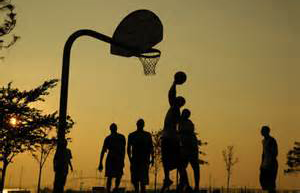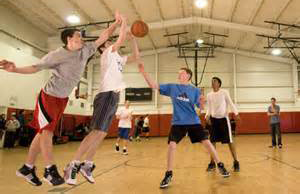- Offensive Techniques & Strategies

Playing Three-on-Three
Players should understand the importance of organizing and playing a lot of three-on-three half court competition during the off season. Since 3-on-3 provides for much more shooting, passing, rebounding, screening, and defensive repetitions, it is by far, the most efficient and effective use of players' time in practicing and improving their basketball skills and techniques.
Full Court Games vs Half Court Games
In a full court game, which takes a approximate a hour and a half, how many shots does a player take? How many rebounds do they grab? How many passes do they make? How many screens do they set and use? How many times do they guard a player with the ball? How many times do they defend against dribble penetration? How many times do they guard a player without the ball?
Compare these figures with the totals that they would receive in playing the same 1 1/2 hours of three on three half court and you will instantly see the importance and value of 3-on-3 in improving and developing individual basketball skills to their fullest.
Playing full court only reinforces current abilities. Very little, if any skill development will take place. In addition, after a long, hard season, 3-on-3 halfcourt games save additional wear and tear of players legs. They also will help eliminate burn-out which can occur when playing full court basketball year around.
Basic 3-on-3 Playing Rules
Each team consists of three players and is played half-court at a single basket.
Scoring consists of two point baskets made from inside the three point line and three points awarded for shots made outside the three point line. If there is no three point line, all shots are worth one point.
Games are played to a pre-determined number of points. Note: It is best to play a series of short games rather than one long game. Normally, a team must win by two points.
To start, one player shoots from the top of the circle. If the shot is made, that team gets the first ball possession. If the shot is missed, the opponent gets ball.
Make it take it. Scoring team retains possession of the ball. Teams must make a defensive stop in order to go on offense. Note: Ball must be checked in by the defense after all made baskets.
On defensive stops (defensive rebounds & steals), the defensive team must take the ball back out beyond the three point line before shooting.
On jump balls, alternate possession. On the first jump ball, the team behind gets possession.
Call your own fouls. This will prevents “TickyTack” calls. No free throws are shot. All fouls are to be checked in at the top of the circle.
No arguing. If there is a dispute, alternating jump ball is in effect.The main objective is repetition and practice of basketball skills, not winning.
Getting the Most Benefit Out of 3-on-3
Offensive Emphasis
Offensively, emphasis should be on teamwork. Creating leads, sharp & accurate passing, timing and spacing, “Give & Go” cuts, Off-Ball and On-Ball screens reads and counters, offensive rebounding, etc.
Defensive Emphasis
Defensively, emphasis should be on On-Ball defense, preventing dribble penetration, strong first pass denials, defending cutters, helpside support, and boxing out fundamentals and techniques.
Self Development
"A game within a game." It is always a good idea to have a specific skill, or closely related skills, to emphasize when playing half court, such as strong pass denials or offensive rebounding, etc. Write it down so you do not forget.
Organized Competition

Play for free: Players can go to a neighborhood park or use a basket at home. Note: Some parks have outstanding outside courts available.
Open Gyms: Rulers of the Court. This three-on-three competition is especially effective during open gyms, tryouts, camps and clinics when there are large numbers of players.
3-on-3 Tournaments: Organized 3-on-3 tournaments will have there own set of Rules & Regulations.
© 2026 HoopTactics All Rights Reserved.
